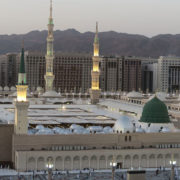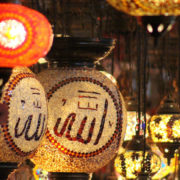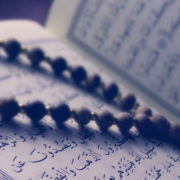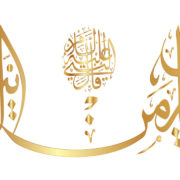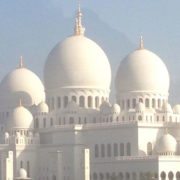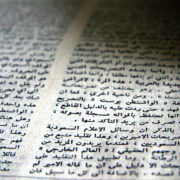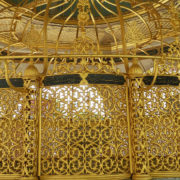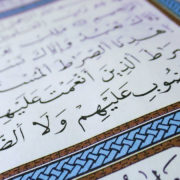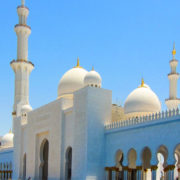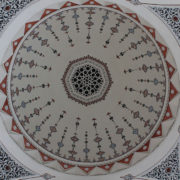Yasin T. al-Jibouri
[email protected]
Waves of visitors have never stopped coming to Kerbala from the time of the Umayyads, who incurred the Wrath of the Almighty when they massacred the family of His Prophet’s grandson, and that of the Abbaside caliphs, who did all they could to prevent the construction of his shrine, till the time when the faithful were finally able to build the precinct despite the hardships and difficulties imposed on them. It befits this text to familiarize the reader with Kerbala.
Two main roads lead the visitor to Kerbala. One is from the Iraqi capital Baghdad, through Mosul, and the other is from the holy city of Najaf. Upon reaching Kerbala, the holy place would draw the visitor’s attention to its magnificent minarets and domes that shine due to the light of their lord. At the city’s entrance, the visitor finds a row of houses decorated with wooden columns, and while proceeding further towards the holy mausoleum, he sees architecture similar, to some extent, to modern ones. Upon reaching the holy shrine, one finds himself in front of a boundary wall that surrounds wooden gates covered with glass decorations. When one enters one of those gates, he enters a precinct surrounded by small rooms called “iwans”. The holy grave is located in the middle of the precinct, surrounded by square shaped structures each of which is called “rawaq”. The grave itself is located in the middle of the grave site with golden windows around it very beautifully illuminated. It really is a great site to see.
“KERBALA”: DERIVATION & MEANING
There are many opinions among different researchers about the origin of the word “Kerbala”. Some have pointed out that “Kerbala” has a connection to the “Kerbalato” language, while others attempt to derive the meaning of the word “Kerbala” by analyzing its spelling and language. They conclude that it originates from the Arabic word “Kar Babel” which was a group of ancient Babylonian villages that included Nainawa (Nineveh), Al-Ghadiriyya, Karbella, Al-Nawawees, and Al-Heer. This last word is now known as Al-Haa’ir; it is here that Imam Hussain’s grave is located. The traveler Yaqut al-Hamawi (1179 – 1229 A.D.), author of Mujma’ al-Buldan, had pointed out that the meaning of “Kerbala” could have several explanations one of which is that the place where Imam Hussain (ع) was killed is made of soft earth, “al-Kerbalat”. Other writers made the connection between the name and the disastrous event which painted the desert with blood, so the word “Kerbala” was said to be comprised of two Arabic words: “Karb”, which means grief and sorrow, and “Balaa”, which means affliction. But Kerbala was known by this name even before the arrival of Imam Hussain (ع).
KERBALA’S POPULARITY
Kerbala was at first an uninhabited place and did not witness any construction activity, although it was rich in water and fertile soil. Following the tenth of Muharram of 61 AH (October 10 according to the Julian or the 13th according to the Gregorian calendar, 680 A.D.), after the martyrdom of Imam Hussain (ع), people from far away as well as tribes living nearby started visiting the holy grave. Many of those who came stayed behind and/or asked their relatives to bury them there after their demise. Despite many attempts by successive rulers, such as Haroun “al-Rashid” (763 – 809 A.D.) and “al-Mutawakkil ala Allah” Ja’far ibn al-Mu’tasim Billah (821 – 861 A.D.), to put restrictions on the development of this area, it has nonetheless spread as time passed by to become a city.
The historian Ibn Qawlawayh[1] has indicated that those who buried Imam Hussain (ع) made a special and rigid construction with signs marking the grave perhaps due to their knowledge of real attempts at the time at defacing it. Higher and bigger constructions above the grave started during the regime of the first Abbaside ruler, “Abul-Abbas” Abdullah ibn Muhammed al-Saffah (the latter title meaning “the blood shedder”) (721 – 754 A.D.), who was busy battling the Umayyads for power. But Haroun al-Rashid later on put heavy restrictions in order to prevent people from visiting the grave. During the time of Al-Ma’mun son of Haroun al-Rashid (786 – 833 A.D.), construction around the grave resumed until the year 236 A.H./851 A.D. when the Abbaside ruler “al-Mutawakkil ala Allah” Ja’far ibn al-Mu’tasim (821 – 861 A.D.) ordered the destruction and interring of the grave, then the filling of the pit with water… His son, al-Muntasir, who succeeded him in 861 and who is suspected of having killed him, allowed people to visit the grave site. Since then, building the precinct to the grave increased and developed step by step.
The historian and biographer “Ibn Al-Athir”, namely Izz ad-Deen ibn al-Athir “Abu al-Hassan” Ali ibn Muhammed al-Jazri (1160 – 1233 A.D.), has stated that in the year 371 A.H./982 A.D., Adud Al-Dawlah “Abu Shuja’ Fana Khosroe son of Rukn al-Dawlah al-Buwayhi عضد الدولة أبو شجاع فنا خسرو بن ركن الدولة who lived from 937 to 983 A.D. and ruled Persia from 951 till his death in 983, became the first to largely lay the foundations for a large scale construction, generously decorating the place. He also built houses and markets around the precinct, surrounding Kerbala with a high boundary wall and turning it into a strong castle. In the year 407 A.H./1016 A.D., the precinct caught fire due to the dropping of two large candles on the wooden decorations, but Hassan ibn Fadl, then state minister, rebuilt the damaged sections.
History has recorded the names of several rulers who shared the honor of expanding, decorating or keeping the precinct in good condition. Amongst them is Fatih Ali al-Qajari who, in 1250 A.H./1737 A.D., ordered the construction of two domes, one over Imam Hussain’s grave and the other over that of his brother, Abu al-Fadl al-Abbas (ع). The first dome is 27 meters high and completely covered with gold. At the bottom, it is surrounded with 12 windows each of which is about 1.25 m away from the other from the inside and 1.30 m from the outside.
The mausoleum has an area of 59 m / 75 m with ten gates, and about 65 rooms (iwans), well decorated from the inside and outside and used as classrooms for studying. As for the grave itself, in the middle of the precinct, it is called the “rawda”, garden, and it has several gates. The most famous of these gates is called that of al-qibla or “bab al-dhahab”, gold gate. Upon entering through it, one can see the tomb of Habib ibn Madhahir al-Asadi to the right hand side. Habib was a friend and companion of Imam Hussain (ع) since their childhood, and he was one of those who were honored with martyrdom in the Battle of Kerbala.
THE RESTING PLACE OF ABBAS SON OF ALI IBN ABU TALIB (ع)
Abu al-Fadl Abbas (ع) was brother of Imam Hassan (ع) and Imam Hussain (ع) and the standard-bearer of Imam Hussain (ع) in the Battle of Kerbala. He is well known in history for his valor, loyalty and similarity to his father, the Lion of God, Ali ibn Abu Talib (ع). The resting place of Abbas (ع) received similar attention as that of Imam Hussain (ع). In the year 1032 A.H./1623 A.D., the Safavid King Tahmasp of Ghazvin, Persia, who ruled from 1500 to 1730s, ordered the decoration of the grave’s dome. He built a window on the ‘darih’ ضريح (shrine) around the grave and organized the precinct. Other similar activities were done by other rulers.
Kerbala contains, besides the grave of Imam Hussain (ع) and his brother al-Abbas (ع), the graves of all the 72 martyrs of Kerbala, all males. They were buried in a mass grave which was then covered with soil up to the ground level. This mass grave is at the foot of Imam Hussain’s grave. In particular, besides Imam Hussain’s grave, there are the graves of his two sons, Ali al-Akbar and 6-month old Ali al-Asghar who was shot with an arrow on the 10th of Muharram as his father pleaded for water for the infant. Imagine the extent of those beasts’ cruelty, and their unrepentant followers, who still live among other Muslims of the world, are no less cruel.
CHRONOLOGY OF IMAM HUSSAIN’S SHRINE AT KERBALA
| AH |
CE |
Events |
| 61 |
lst October, 680 |
Imam Hussain (ع) was buried at this sacred spot. |
| 65 |
18th August, 684 |
Al-Mukhtar ibn Abu Ubaidah al-Thaqafi built an enclosure around the grave in the form of a mosque and erected a dome over the grave. There were two entrances to this building. |
| 132 |
12th August, 749 |
A roof was built over a portion of this mosque and two entrances were added during the reign of Abul-Abbas al-Saffah, founder of the Abbasid dynasty. |
| 140 |
31st March, 763 |
The roof was demolished during the reign of Abbasid al-Mansur al-Dawaniqi. |
| 158 |
11th November, 774 |
During the reign of al-Mahdi, the Abbaside ruler, the roof was reconstructed. |
| 171 |
22nd June, 787 |
During the reign of Haroun al-Rashid, the dome and roof were demolished and the plum tree, which stood near the grave, was cut down. |
| 193 |
25th October, 808 |
During the reign of al-Amin son of Haroun al-Rashid, the building was reconstructed. |
| 236 |
15th July, 850 |
Abbasid ruler al-Mutawakkil demolished the buildings and ordered the plot ploughed. |
| 247 |
17th March, 861 |
Al-Muntasir built a roof over the grave and set up an iron pillar near it to serve as a landmark for the pilgrims. |
| 273 |
8th June, 886 |
The roof was demolished again. |
| 280 |
23rd March, 893 |
The Alid representative built a dome in the centre, with two roofs, on either side and an enclosure with two entrances. |
| 307 |
19th August, 977 |
Adud ad-Dawlah ibn Buwayh عضد الدولة أبو شجاع فنا خسرو بن ركن الدولة Adhud ad-Dawlah “Abu Shuja’” Fana Khosroe son of Rukn ad-Dawlah, who lived from 937 – 983 A.D. and ruled from 951 – 983 A.D., rebuilt the dome, the surrounding galleries and constructed a screen of teak wood around the sepulchre. He also constructed houses all round the shrine and erected the city’s boundary wall. At the same time, Imran ibn Shahin (d. 979 A.D.) built a mosque adjacent to the tomb. |
| 407 |
10th June, 1016 |
The buildings were damaged by fire and Vizier al-Hassan ibn al-Fadl rebuilt them. |
| 620 |
4th February, 1223 |
al-Nasir li Deenillah أبو العباس “الناصر لدين الله” أحمد بن الحسن المستضئ, namely “Abu al-Abbas” Ahmed ibn al-Hassan al-Mustadhee’ (1158 – 1225 A.D.), the Abbaside ruler who ruled for almost 50 years, reconstructed the screens of the sepulchre. |
| 757 |
18th Sept. 1365 |
Sultan Owais ibn Hassan al-Jala’iri السلطان أويس بن حسن الجلائري (1374 – 1382 A.D.), one of the Moghal (Moghul, Mughul, Moghol) Jala’iri sultans who ruled Iraq, remodeled the dome and raised the walls of the enclosure. |
| 780 |
24th Feb. 1384 |
Sultan Ahmad ibn Sultan Owais (who ruled briefly from 1382 to 1383 A.D. after seizing power from his brother, Sultan Ali) erected two minarets covered with gold and extended the courtyard. |
| 920 |
26th Feb. 1514 |
Safavid Shah Isma’il أبو المظفر شاه إسماعيل الهادي الوالي الصفوي namely “Abū al-Muzaffar” bin Haydar bin Sheikh Junayd as-Safawī (the Safavid) (July 17, 1487 – May 23, 1524), founder of the Safavid Shi’ite Empire which survived until 1736 A.D., visited the holy shrine and built a sacrophagus of the inlaid work over the grave. |
| 1032 |
5th Nov. 1622 |
Safavid Shah Abbas, also known as “Abbās the Great”, who was born on January 27, 1571 and died on January 19, 1629) and was shah of Persia from 1588 to 1629, constructed the screens (darih ضريح) of brass and bronze and decorated the dome with Kashi tiles. |
| 1048 |
15th May 1638 |
Ottoman Sultan Murad IV, who was born on June 26, 1612 in Istanbul (Constantinople, city of emperor Constantine who built it), and whose father was Sultan Ahmet (Ahmed) I, visited the holy shrine and whitewashed its dome. |
| 1155 |
8th March 1742 |
Nadir (or Nader) Shah, namely Nāder Shāh Afshār (Persian: نادر شاه افشار; also known as Nāder Qoli Beg – نادر قلی بیگ or Tahmāsp Qoli Khān – تهماسپ قل), who was born in November of 1688 and died on June 19, 1747, ruled as Shah of Iran from 1736 – 1747 A.D. and was founder of the Afsharid dynasty, visited the holy shrine, decorated the building and offered valuable presents to the shrine’s treasury. |
| 1211 |
7th July 1796 |
Shah Muhammed Qajar, namely Muhammed Shah Qajar (born Mohammad Mirza, Persian: محمد شاه قاجار), who was born on January 5, 1808 and died on September 5, 1848, was king of Persia from the Qajar dynasty which ruled from October 23, 1834 to September 5, 1848. Muhammed Shah was son of Abbas Mirza, the crown prince and governor of Azerbaijan, who in turn was the son of Fat′h Ali Shah Qajar, the second Shah of the Qajari dynasty. His rule lasted for about 40 days. He was quickly deposed at the hands of Mirza Abolghasem (Abul-Qasim) Ghaem Magham Farahani, a politician, scientist, and poet. Shah Muhammed Qajar covered the dome of Imam Hussain’s shrine with gold. |
| 1216 |
14th May, 1801 |
Wahhabis from Saudi Arabia raided Kerbala, spoiled the screens and portico and looted the shrine. |
| 1232 |
21st Nov., 1817 |
Fateh Ali Shah Qajar, or Fat′h Ali Shah Qajar or Fathalishah or Fathali Shah or Fath Ali Shah (In Persian, he is known as فتح على شاه قاجار), was born on September 5, 1772 and died on October 23, 1834. Fateh Shah was the second Qajar king of Iran. He ruled from June 17, 1797 to October 23, 1834. He repaired the screens of Imam Hussain’s shrine and plated them with silver. He also plated the center of the main portico with gold and repaired the damage done by the professional Wahhabi looters. |
| 1283 |
16th May, 1866 |
Nasiruddin (or Naser al-Din) Qajar Shah of Persia, who lived from 1831 – 1896 A.D., extended the courtyard of the shrine. |
| 1358 |
21st February, 1939 |
Dr. Syedna Taher Saifud-din, or Taher Saifuddin, (in Arabic, (سيدنا طاهر سيف الدين who lived from August 1885 to November of 1965, was leader of the Dawoodi Bohras (Shi’a) community (of Mumbai, India) from 1915 to 1965. He offered a set of screens of solid silver which remain fixed in the shrine. He also rebuilt the western minaret in January of 1941. |
| 1367 |
20th Dec., 1948 |
Sayyid Abdul Rasoul al-Khalsi عبد الرسول الخالصي, attorney and once minister of justice in Iraq, who was at the time administrator of Kerbala, acquired the houses in the neighborhood of the courtyard according to the price fixed by the government in order to build a road around the holy mausoleum and extend the courtyard. |
[1] His name is “Abu al-Qasim” Ja’far ibn Muhammed ibn Ja’far ibn Mousa ibn Qawlawayh al-Qummi, the senior faqih mentor, a man of high prestige, reliability and in-depth researching in fiqh and hadith. Ibn Hajar al-Asqalani regards him as one of the senior and renown Shi’a scholars. His date of birth is unknown but he died in 368 or 369 A.H./979 or 980 A.D.

